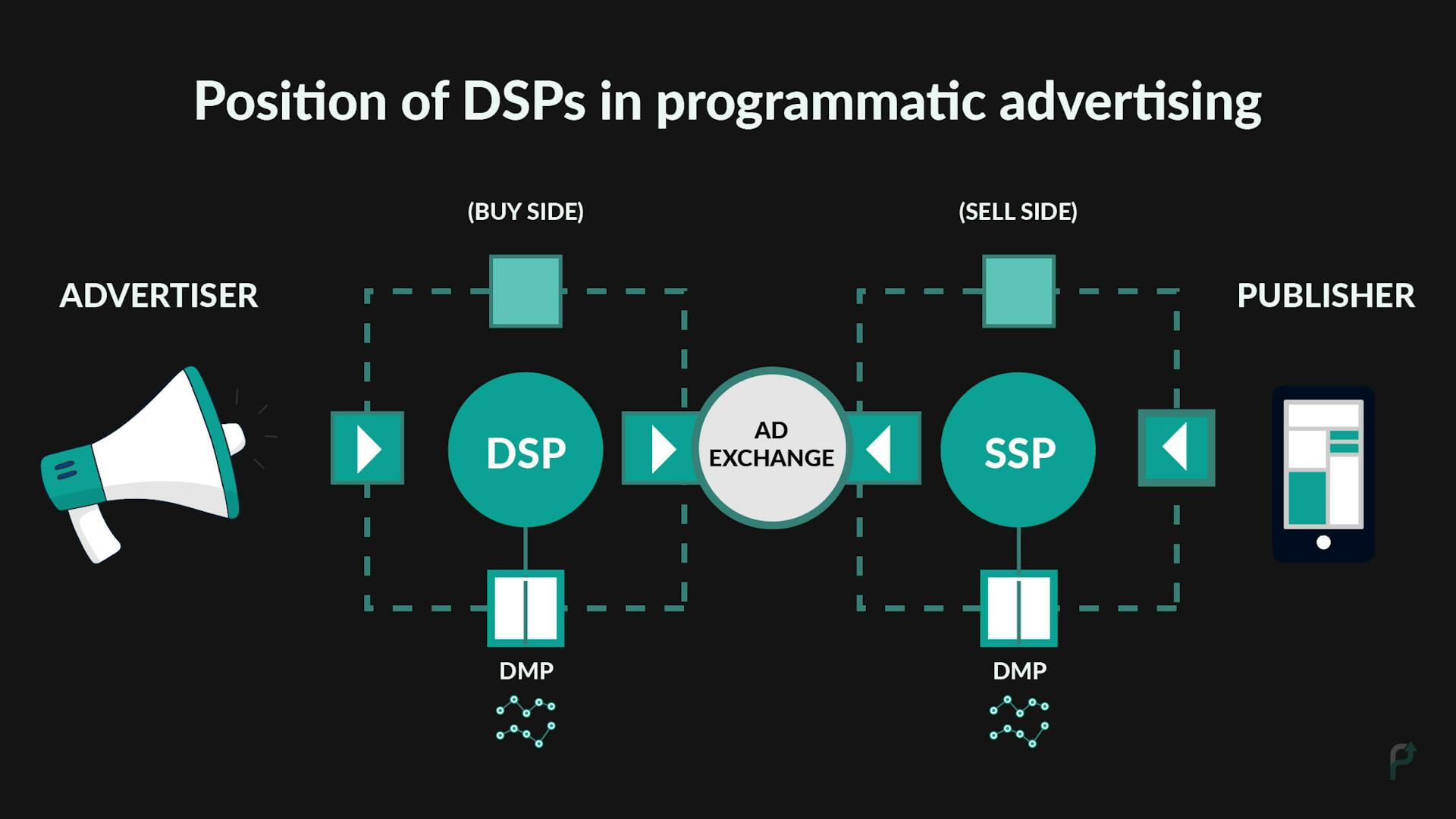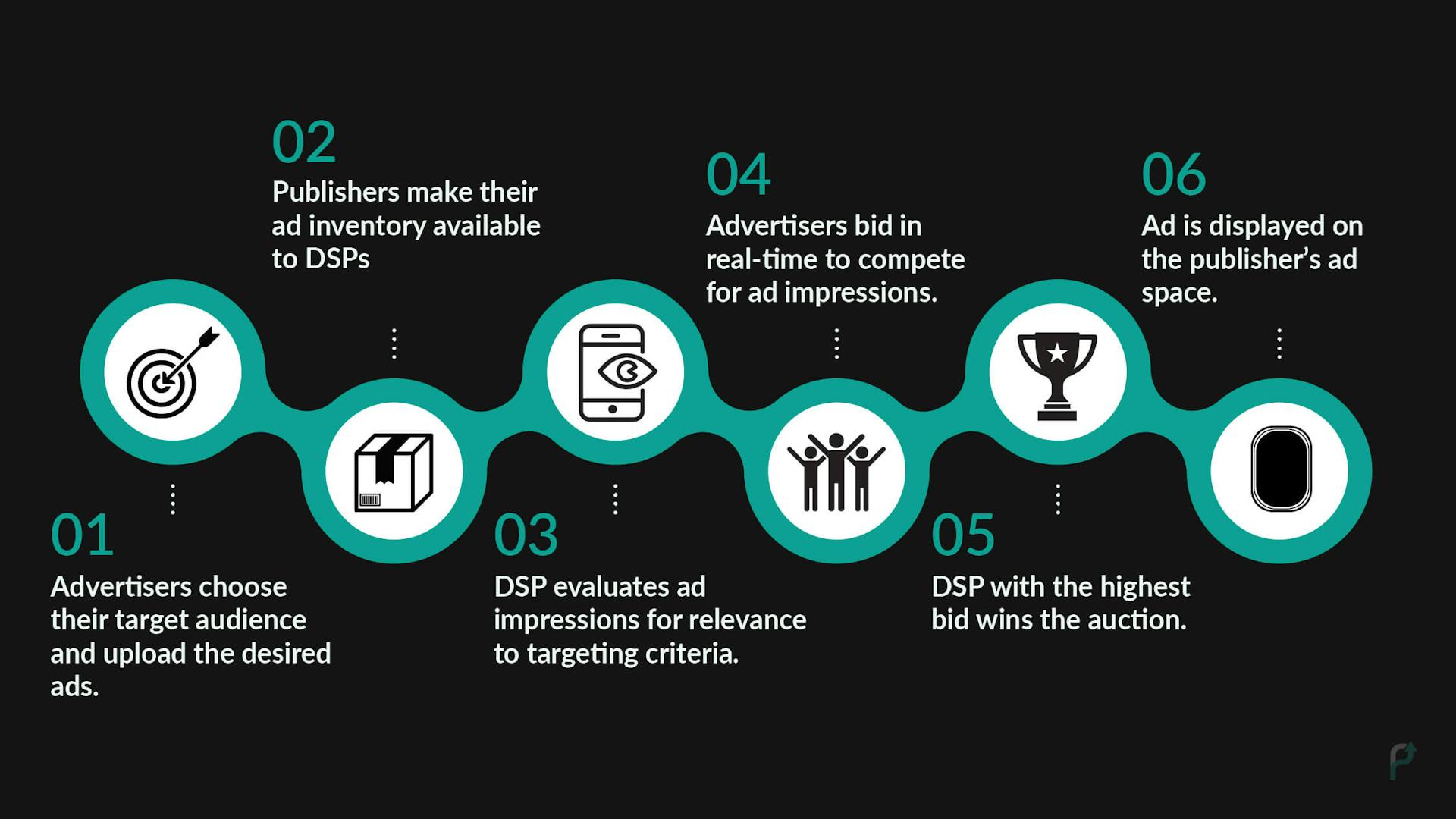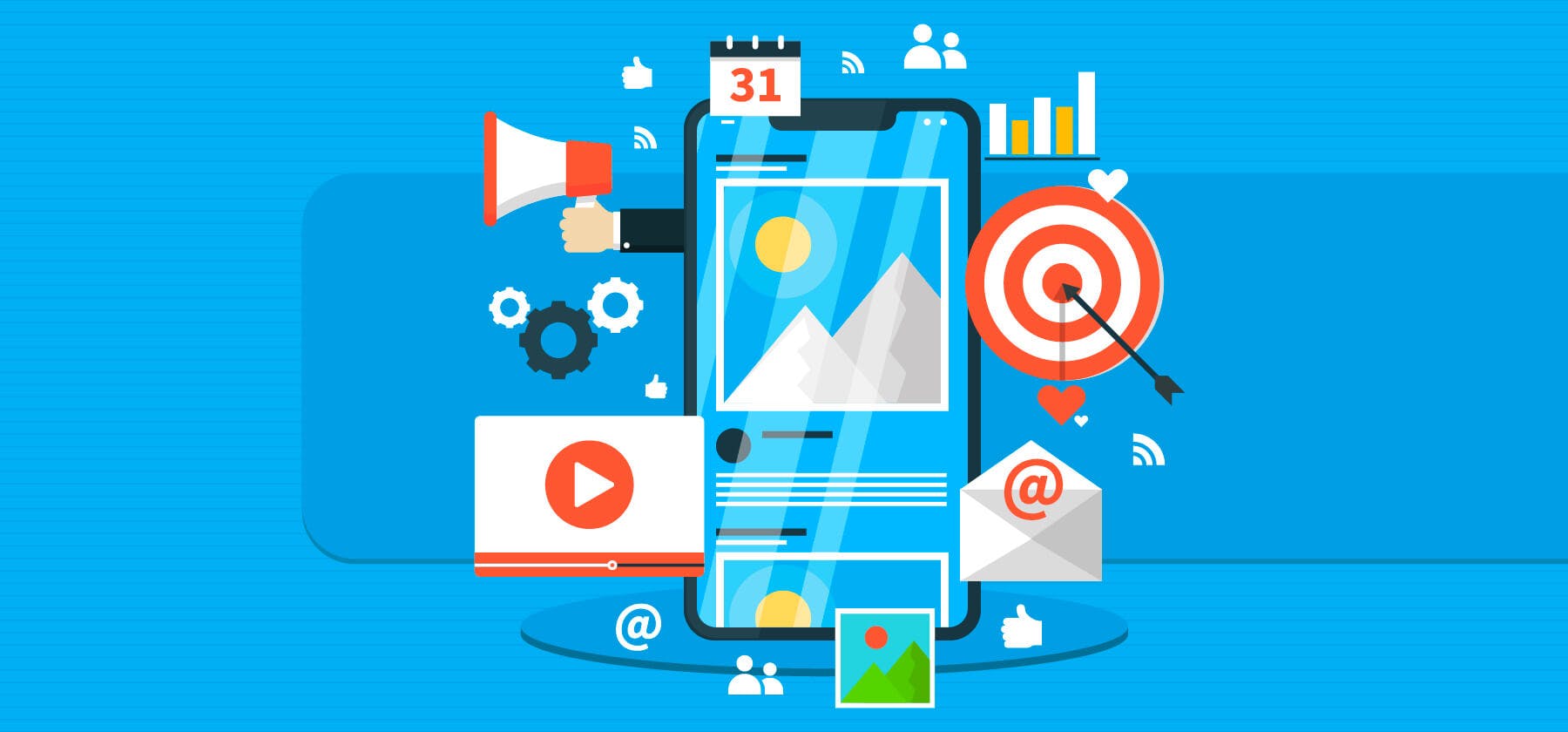Due to brands' increasing interest in paid marketing, programmatic advertising is experiencing tremendous growth, with expected ad spending to reach $141.9 billion in 2024. However, advertisers still face many challenges while buying the right ad spaces. Demand Side Platforms (DSP) solve these problems, thanks to their powerful AI algorithms.
Let’s explore end-to-end information about demand-side platforms and understand how they help advertisers.
What is a Demand Side Platform (DSP)
A demand-side platform is a programmatic platform used by advertisers and media agencies to purchase and manage digital ad inventory from multiple resources such as ad exchanges, ad networks, direct publishers, and Supply-Side platforms (SSPs) - all through a single interface.
 Position of DSPs in Programmatic Advertising
Position of DSPs in Programmatic AdvertisingDSP is backed with real-time bidding to enable the buying of programmatic ad impressions, targeting specific audiences based on relevant data, thereby automating the whole ad buying process. Some popular DSPs include Display and Video 360 from Google, and Meta Ads Manager from Facebook.
What is a Mobile DSP
Mobile DSP offers the exact functionalities and features of a regular demand side platform, i.e., automated buying of ad inventories. However, a mobile DSP is explicitly designed to support media buying on mobile devices.
How does a Demand-Side Platform work
 How Does a DSP Work
How Does a DSP WorkA demand-side platform automates the ad-buying process and connects advertisers with digital publishers via ad exchanges. Here’s a step-by-step walkthrough of how demand side platforms work:
- Advertisers choose their target audience and upload the desired ads.
- Publishers make their ad inventory available to demand-side platforms through ad exchanges and supply-side platforms.
- The DSP evaluates ad impressions for relevance to targeting criteria and submits a bid to purchase user impressions.
- Advertisers bid in real time to compete for ad impressions.
- The demand side platform with the highest bid wins the auction.
- The ad is displayed on the publisher’s ad space
This entire process occurs within 200 milliseconds of a user visiting the publisher's app or website.
Your app, our expertise: Elevate strategy with Mobile DSP.
Relevant Demand Side Platforms Types Today
The following two types of demand-side platforms are relevant among advertisers today:
-
Self-Serve Demand-Side Platforms
Self-service demand side platforms give advertisers complete control over their ad campaigns, from creation to management and optimization, eliminating the need for a campaign manager. This type of DSP shifts the responsibility for ad campaign development, execution, and evaluation entirely to the advertiser, potentially reducing overhead costs and providing complete campaign control.
-
Full-Service Demand-Side Platforms
A full-service demand-side platform provides advertisers with account management and sales representative support to manage their ad campaigns. When utilizing this DSP type, advertisers must commit to a minimum budget for each campaign.
Key Features of Demand-Side Platforms
-
Smart Audience Targeting
Demand-side platforms should have capabilities such as demographic targeting, geo-targeting, behavior targeting, retargeting, and device targeting to reach the desired audience.
-
Real-Time Bidding (RTB)
RTB facilitates instant buying of digital ad impressions, allowing advertisers to check the live prices and make decisions accordingly. Real-time bidding occurs in milliseconds, even less than the time a web page or app takes to load.
-
Granular Analytics
Real-time analytics and insights help advertisers track the progress of their campaigns and understand how the existing campaign performance can be improved.
-
Campaign and Budget Management
To ensure all your campaigns are monitored and managed in one place, demand-side platforms should support advanced campaign management features such as programmatic buying, powerful tracking, and granular ad performance details. Similarly, to ensure your campaigns do not exceed the allocated budget, DSPs should enable advanced budgeting options to show the budget status daily.
Core Components of a DSP
-
Ad Server
The ad server in DSP is a component that is responsible for sending required elements to the ad spaces on the publisher’s app or website. Also, ad servers track impressions and associated conversion data to help optimize the existing campaigns.
-
Bidder
Bidder is an integral part of DSP as it places bids on the ad impressions via real-time bidding which completes in milliseconds, less than the time a user spends on opening a website.
-
SSP and Ad Exchange Integration
Knowing that DSPs are designed to provide advertisers with premium ad inventory, they must support SSP and ad exchange integration to be able to access the available inventory.
Advantages of Demand-Side Platforms
Demand-side platforms are important for advertisers as they automate the media buying process and allow them to advertise across multiple networks in real time. With an automated approach, advertisers no longer have to go through the pain points of manual ad inventory buying.
By spending less time, energy, and investment on the programmatic advertising process, advertisers get more time to easily set up, customize, and manage their digital campaigns.
Top Demand Side Platforms available
The following are the examples of top-performing demand-side platforms:
- PubScale
- Google Display & Video 360 (DV360)
- Amazon DSP
- Adobe Advertising Cloud
- MediaMath DSP
- Verizon Media DSP
- Beeswax
- The Trade Desk
Start acquiring users easily with the best mobile demand side platform
Understanding DSP vs SSP
DSP and SSP are two unique programmatic advertising platforms with distinct features and benefits. However, people often seem confused about differentiating between the two. Therefore, let’s examine the difference between DSP and SSP.
| Basis | Demand-Side Platform (DSP) | Supply-Side Platform (SSP) |
|---|---|---|
| Purpose | Enables advertisers to buy and manage digital ad inventory | Enables publishers to sell their ad inventory |
| Users | Advertisers and media agencies | Publishers and app developers |
| Inventory | Buys ad inventory across multiple ad exchanges and SSPs | Sells ad inventory across multiple ad exchanges |
| Functionality | Uses algorithms and real-time bidding to target and optimize ad campaigns | Provides tools for inventory management, ad serving, and revenue optimization |
| Key Features | Advanced targeting and optimization, data management, real-time reporting, and analytics | Inventory management, yield optimization, and ad serving |
| Integration | Integrates with DMPs, ad servers, and creative management platforms | Integrates with ad exchanges, ad networks, and ad servers |
| Goals | Drive conversions and improve ROI for advertisers | Maximize revenue and fill rates for publishers |
In layman's terms, DSP and SSP connect two different programmatic ecosystems that serve two unique purposes. A demand-side platform helps advertisers to fine-tune ad buying and supply-side platforms assist publishers in selling their ad inventory at the desired price.
Choosing the Right Demand-Side Platform
When it comes to choosing the best demand-side platform, there are several key points to keep in mind. The best DSP for your organization will depend on your specific needs and goals, but here are some factors to consider when making a decision
- Target audience: It's important to choose a DSP that has access to the inventory that your target audience is most likely to engage with. This could include specific websites or mobile apps, for example.
- Features: Consider the range of features offered by the DSP, including targeting options, reporting capabilities, and integration with other marketing tools. This will help ensure you can meet your advertising goals and measure your results effectively.
- Ad format: Look for a DSP that supports the ad format you want to use, such as display, video, or native ads. This will allow you to create ads that are optimized for your target audience and the channels where you'll be running your campaigns.
- Inventory: Check the inventory of the DSP to ensure it includes the ad placements you want to use. This will help ensure that your ads are displayed on the right channels and in the right locations.
- User interface: Look for a DSP with an intuitive and user-friendly interface that is easy to navigate and use. This will help you manage your campaigns more efficiently and effectively.
- Customer support: Evaluate the quality of the DSP's customer support, including availability, responsiveness, expertise, and resources, such as onboarding and training help. This will help ensure that you have the support you need to run your campaigns successfully.
- Pricing: Determine if the DSP's pricing model fits within your budget and aligns with your advertising goals. This will help you manage your costs effectively and get the best ROI for your campaigns.
- Data management: Evaluate the data management capabilities, including data privacy and security measures. This will help ensure that your data is protected and that you are using it in compliance with relevant regulations.
- Targeting capabilities: Look for audience segmentation, advanced data targeting, and retargeting options to reach your audience effectively. This will help you create more targeted campaigns that resonate with your target audience.
- Reach: Ensure the DSP offers a global reach and has access to global inventory, including mobile, video, and programmatic advertising. This will help you reach your target audience no matter where they are located.
- Performance metrics: Evaluate reporting and analytics capabilities, including ROI and conversion tracking. This will help you measure the success of your campaigns and make adjustments as needed to optimize your results.
Conclusion
Demand-side platforms have transformed the way programmatic advertising has been working for years. With its ability to automate ad buying in real-time and consolidate with supply-side platforms, DSPs have become a must-have tool for worldwide advertisers. We expect to see more feasible features and components on the demand-side platforms in the coming time.
The only ad platform built for developers by developers.
Contact us now for a product that fits your needs! It’s quick, simple and easy.



